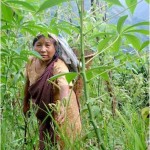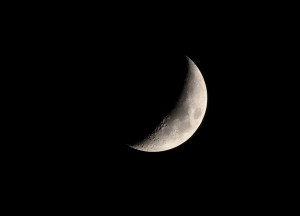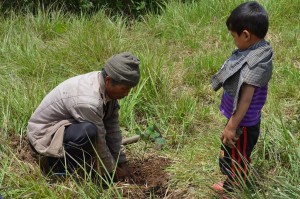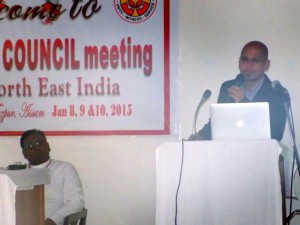by Pius Ranee

A few years ago, while visiting a jhum field along with two of my friends, an incident occurred that opened my eyes. To get to the jhum field we had to cross a small stream. While crossing it, one of my friends slipped and hurt himself badly. He was bleeding profusely from the wound on his leg and at that moment I felt completely helpless. While I stood there watching, my other friend did something very strange. He ran into the bushes nearby, found a plant, plucked the leaves and put in his mouth and began chewing. Then to my wonder, he took the chewed leaves and applied the paste to the wound of the injured friend. In no time the bleeding stopped. Initially, I was amazed at his knowledge but then I suddenly realized that the plant he used to medicate the wounded boy was a common plant that the people of my village used to treat cuts and wounds as well. The plant is known as “U sla jumai” in my language.

I come from a tiny and wonderful village called made up of 37 households called Nongtraw. The year was 2010, the month was November. Something life changing happened to me and my community. The entire Nongtraw community was invited to the Mother Earth Festival at Mawphlang Village organized by Mr Phrang Roy and his Rome based Indigenous partnership for Agrobiodiversity and Food Sovereignty. We took this opportunity to show case our local products like sweet potatoes, yam, tapioca, wild potatoes which are the main produce of our land.

Impressed by our local produce, February 2011; Bah Phrang Roy, Chairman NESFAS and my mentor introduced us to Sara Asadullah- a lady from London to help us document some of our traditional knowledge, which are fading away, through a Participatory Video programme. Participatory Video or PV is a technique which requires the involvement of a group or community in shaping and creating their own film. Sara Asadullah sat down with us and helped prepare a story board about some of the crops that we felt were important to our community and were fading away. Through an interesting exercise with her, we found that it was a great instrument to bring us together to discuss and brainstorm the issues which affect our life.

Have you ever felt a sort of a power when you hold a mike in front of the camera? Or have you ever felt the power when holding a pen? When Sara taught us to hold the camera, we realised that it was mightier than the sword or the pen or even the microphone. In this process we became decision makers. Video making brought our people together and gave us the tool to voice our concerns regarding issues close to our heart. For example, through PV documentation, we were able to rediscover our traditional crops like millet and Shiahkrot, a herbal tea leaf.
We also found that this PV became a useful platform as it made young people like me realize that traditional knowledge can be glamorised through this modern tool. Speaking personally, the camera helped me realize the richness in our diversity and culture.

So with the help of Sara Asadullah, Insightshare, a UK/France based organisation pioneering the use of Participatory Video as a tool for empowering individuals and a simple camera, we decided to make a video about the life and practices of my community. Through it we were able to capture the traditional knowledge of our forefathers and pass it down to future generations. Even today during any special occasion we screen the videos we made in order to reflect and raise awareness on the issues. Now it makes me proud to see that this simple tool had made a great impact in my community. Since then, more elders have joined the youth to make films and the number of families growing millet has gone up from 4 households in 2010 to 25 households in 2013. The Village Development Committee has now taken a grant from the Khadarshnong Socio Organisation to buy a piece of community land where all the members of the community will have access to. Approximately 80% of the land will be used to grow millet. Millet is our traditional crop which can be used as an emergency food source. It is highly nutritional, and can be stored for a long time.
Another positive outcome of the Participatory Video was that a Custodian farmer named Bibiana Ranee, who happens to be my mother, was selected to deliver a speech at the Indigenous Terra Madre which was held in the town of Jokkmokk, Sweden, in 2011 and also during in the last slow food conference in 2012, in Turin Italy. The North East stall had the photo of my mother with the title “no women no krai” meaning no women no millet.

With the help of the Indigenous Partnership, Rome, led by Mr Phrang Roy, a global indigenous millet network was started. My small village has now made a global history and I am very proud of this. When a question was raised regarding the impact of the video, Mr Carmelus Ranee, a respected elder who is also an experienced farmer, proudly said “If you go and see our fields are full of millet. All our children now know the taste of Shiahkrot.”Within duration of three years, this small initiative had spread to 14 other villages of Meghalaya. We are also connected with millet growers from Nagaland, South India and Thailand through the Mei Ram-ew festival that NESFAS organises every year.
In conclusion I would like to convey a message that comes straight from my heart. This process of PV has helped me and my community to document our oral history. It has helped us bridges the gap between today and the future. Above all, PV documentation has helped me realize that there is still a lot of meaningful knowledge in my community that need to be documented so that the future generation will not forget just like me, a simple local life saving solution that saved my friend that day when we were on the way to the jhum field.
Link to a Participatory Video made by the people of Nongtraw: http://www.youtube.com/watch?v=ZeHxYpPAo_Y
(This is a transcript of the speech Pius ranee gave while representing NESFAS at the TEDxUTM Shillong. He was one of the 11 speakers at this independently organised TED event in Shillong that took place on the 31st of January 2014, at the U Soso Tham Auditorium)
http://www.youtube.com/watch?v=k-1F1hGMz3w



